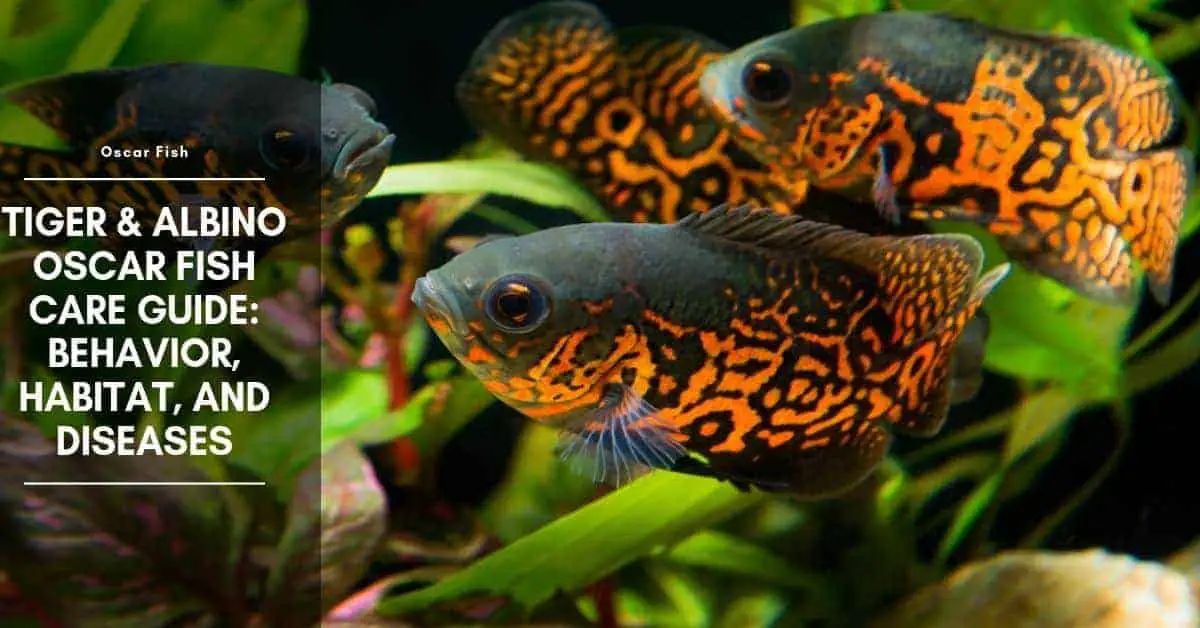Tiger And Albino Oscar are a species of tropical aquarium fish belonging to the family Cichlidae, one of the world’s largest families of freshwater fishes. This species of fish is found in a variety of habitats throughout the Amazon region, and it is one of the most attractive species of freshwater aquarium fish.
Even though Oscars grow very slowly, they can become quite large over the course of their 15 to 20-year lifespans. Unfortunately, many novice aquarium hobbyists do not realize just how big these fish get. They are unprepared when their juvenile Oscars outgrow their 20- and 30-gallon tanks.
Oscar tank requirements
| Tank Size | Minimum 55 gallons for 1 oscar, 75-gallon tank recommended |
| Water Temperature | 72°F -78°F |
| pH Level | 6.0-7.5 |
| Maintenance | Weekly water changes up to 50%, Change filter media monthly |
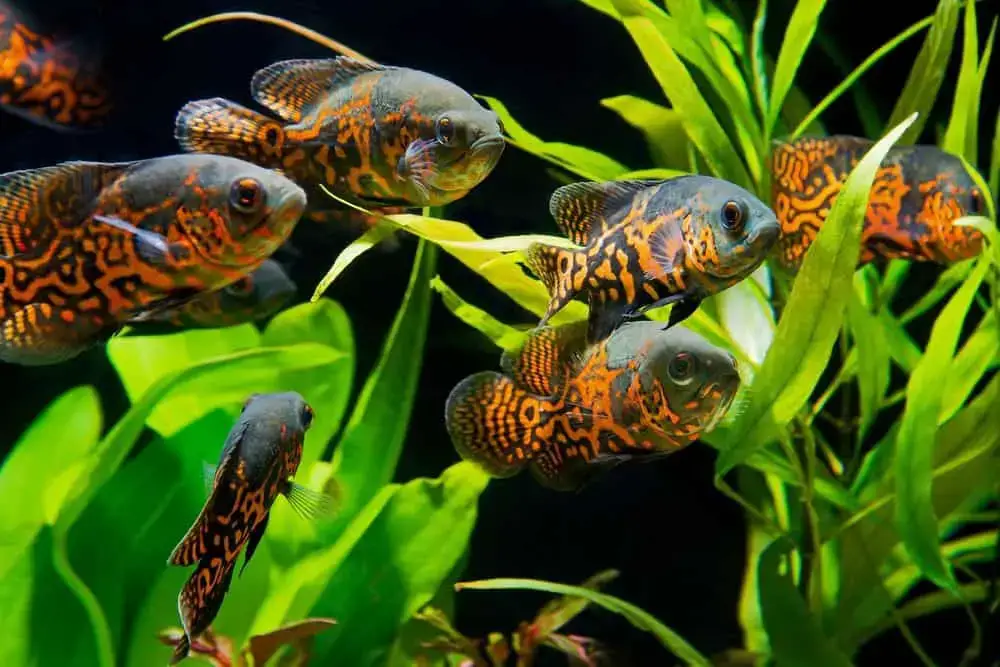
Raising an Oscar can be an incredibly rewarding experience, mainly because of these fish act more like “pets” than just about any other species. Some aquarium hobbyists describe the behavior of Oscars as similar to pet dogs — they have been known to beg for food. They can be taught to perform simple tricks, and they quickly learn to recognize their owners.
They may become more active and attention-seeking in the presence of their owners. All of these exciting behaviors make Oscars a joy to own, but you should still be aware of the challenges of keeping these fish.
Because they grow so large, Oscars require a huge tank. Oscars are typically peaceful by nature, but in some situations, particularly in overcrowded tanks, they have been known to become territorial and aggressive.
If you are in the market for an adventure, breeding Oscar fish is fairly easy, and it can be an enjoyable learning experience for the novice aquarium hobbyist. Not only will you benefit from the experience of conditioning and spawning a breeding pair, but you will also get to witness a variety of intriguing breeding behaviors such as tail slapping and lip-locking as your Oscars court each other.
Oscar Fish Facts
Oscars are a large species of cichlid that goes by the scientific name Astronotus ocellatus. This species is also known by the nicknames Velvet Cichlid, Peacock Cichlid, and Walnut Cichlid, though Oscar is the most commonly used name.
These fish are incredibly popular in the aquarium hobby industry and, due to their popularity, breeders have developed several ornamental strains of the breed. In addition to the occasional wild-caught and the more common commercially bred Oscar, you may also walk into your local pet store one day to find a “tiger” or “albino” Oscar for sale. In recent years, a long-finned Oscar variant has also become available.
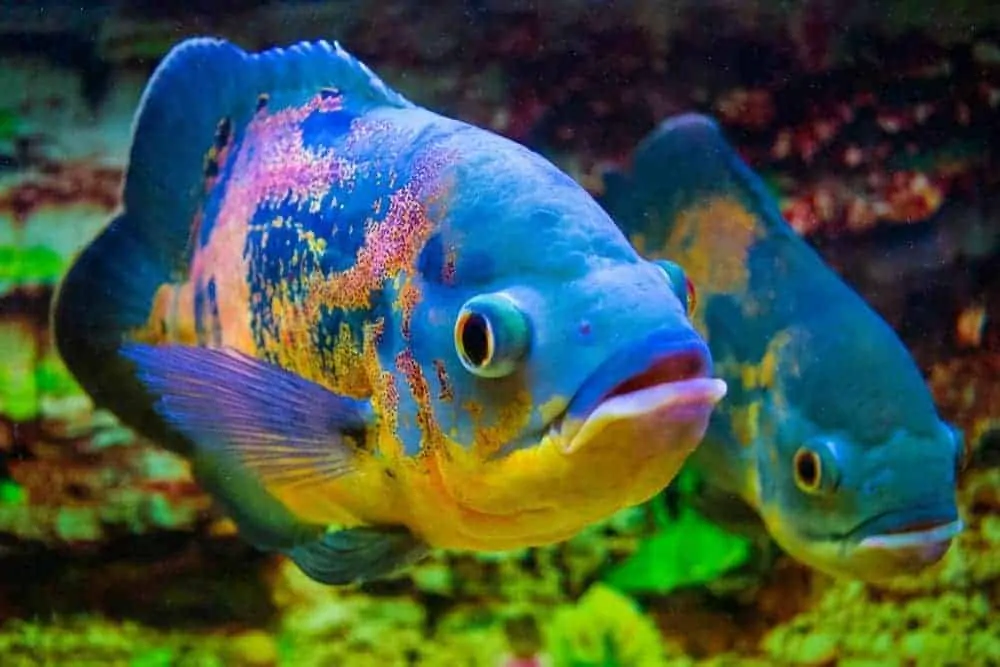
Oscar fish are unique among tropical aquarium fishes because they have been known to display several interesting behaviors. These fish tend to become more like “pets” than any other fish because they develop individual personalities and sometimes interact with their owners.
Just because these fish are entertaining and enjoyable to own, however, doesn’t necessarily mean it is easy to care for an Oscar. Not only do these fish require huge tanks, but they can also be temperamental at times, and they have a very long lifespan. If you are up to the challenge of setting up and maintaining a very large tank, and if you are ready to accept the 15- to 20-year commitment of caring for an Oscar, cultivating an Oscar tank can be an enriching experience.
The natural habitat of Oscar fish
The native habitat of Oscar fish is widely distributed throughout the Amazon region including portions of Venezuela, Bolivia, Colombia, Ecuador, Brazil, Peru, French Guiana, Argentina, and Uruguay. These fish have been found in many river systems throughout the Amazon region, and small feral populations have also been discovered in the United States and Singapore.
Though these fish are widely distributed in their native environment, Oscars available for the aquarium trade are typically supplied by commercial breeders in eastern Europe. Wild-caught specimens are sometimes available, but commercially-bred Oscars are often more desirable because they are more adaptable when it comes to tank parameters.
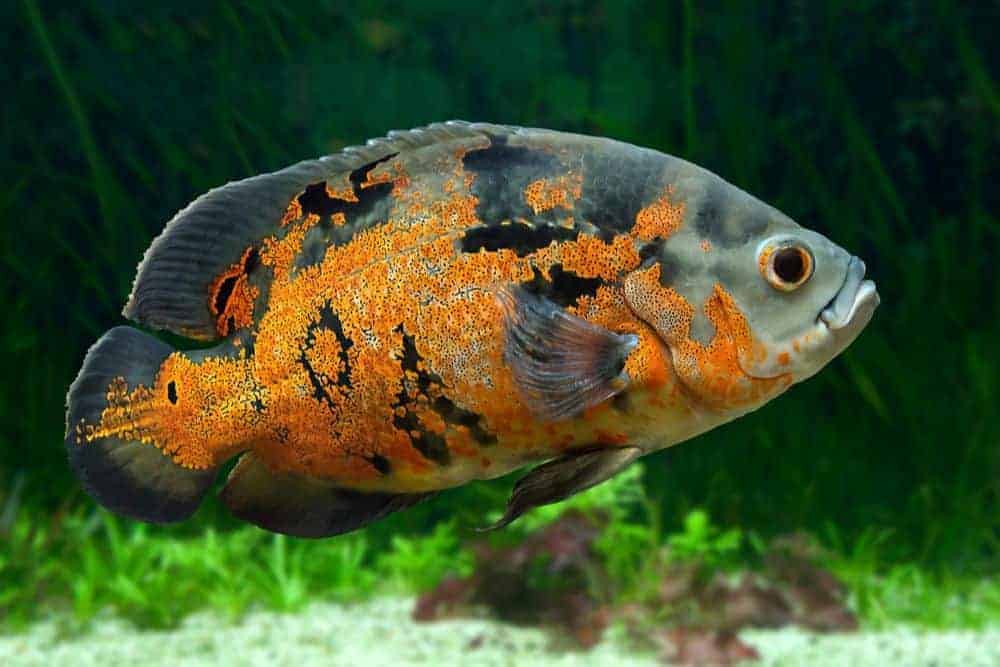
In the wild, Oscars tend to inhabit shallow, slow-moving waters. Thus, in the home aquarium, these fish prefer filtration that doesn’t produce a strong current. Throughout the rivers of the Amazon region, Oscars have been known to hide amongst submerged tree roots, lurking in the shade provided by marginal vegetation. To ensure that your Oscar thrives in his captive environment, it is wise to imitate these conditions in your home tank.
Be careful when decorating your aquarium, however, because Oscars tend to dig up live plants and to root through the substrate. You can still decorate your Oscar tank using some elements from the native environment. You need to be careful when selecting your decorations to ensure that you do not put your Oscar in harm’s way.
Colors, lifespan, and size
Oscars are a species of cichlid, and they typically grow up to 16 inches in captivity and can weigh up to 3-5 pounds. Not only are these fish very large, but they also have a very long lifespan — typically between 15 and 20 years. Wild-caught Oscars are generally dark with reddish coloration on the lower half of the body and orange-rimmed spots (called ocelli) scattered along the base of the caudal and dorsal fins.
API STRESS COAT Aquarium Water Conditioner 16-Ounce Bottle
29% OffAPI STRESS ZYME Freshwater and Saltwater Aquarium Cleaning Solution 1-Ounce Bottle
13% OffAPI ACCU-CLEAR Freshwater Aquarium Water Clarifier 4-Ounce Bottle
18% OffTiger and Albino Oscar fish
Thanks to selective breeding, “tiger” and “albino” strains of this species are also available. Tiger Oscars typically have a dark bluish-black coloration overlaid with orange-red stripes or splotches that resemble the appearance of a tiger’s hide. Albino Oscars look very similar to traditional Oscars except their dark background coloration has been replaced with white.
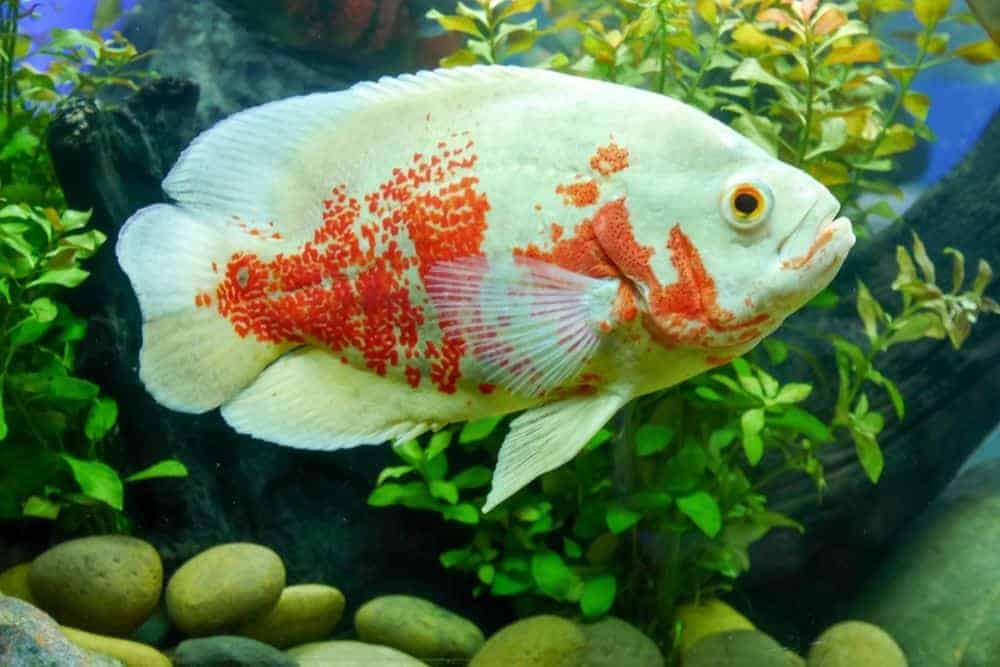
How to tell if a fish is male or female?
When it comes to telling male and female Oscars apart, there is little you can do. This species is typically regarded as being “sexually monomorphic” which means that there is little discernible difference between the two sexes. One of the only ways that the sexes can be distinguished from one another is the fact that male Oscars tend to grow more quickly and.
In some strains, they may also develop dark splotches along the base of the dorsal fin. Oscars are bi-parental substrate spawners — both the male and female take part in the care of the fry, and they tend to spawn in depressions dug in the substrate. Adult Oscar fish reach sexual maturity at one year of age and, once they reach maturity, they will continue to reproduce for up to ten years.
Oscar fish behavior
Oscars are known for their intelligence as well as their tendency to develop something of a personality. These fish have been known to interact with their owners, begging for food, and even following the movements of their owners on the other side of the tank walls. Though they are sometimes mistakenly described as a vicious species, Oscars are typically fairly peaceful.
There are situations, however, in which an Oscar may become aggressive. During the breeding season, Oscars may become territorial and, after spawning, they may guard their fry fiercely. Inadequate tank space for multiple male Oscars could also lead to problems with aggression and territoriality, which could result in fighting and injury or death in one or both of the rival males.
Another potential problem regarding Oscar behavior is that they may end up eating their tank mates if they are kept with significantly smaller fish. Though Oscars do not require live fish as part of their diet, they may see smaller species such as tetras and livebearers as prey.
Hole in the head and fin rot diseases
Though Oscars can develop many of the same diseases as other aquarium fish, the most common diseases to which they are prone include hole in the head and fin rot.
Hole in the head
Hole in the head, also called lateral line erosion, is a disease that causes the formation of small pits and lesions on the head that may spread to the mouth, gills, and eyes. Not only can hole in the head disease lead to permanent scarring but, in severe cases, it can also be fatal.
Though treating hole in the head disease can be tricky, prevention of the disease is pretty straight forward. The key to preventing this disease is to keep the water quality in your tank high. Maintain regular water changes and test your water quality frequently using an aquarium water test kit.
Fin rot
Fin rot is another disease commonly affecting Oscars. This disease typically manifests in the form of red streaks on the fins of Oscars which progresses into decay and rot, making the fins appear ragged and torn.
Severe infections can destroy the fin, leaving a stump in its place, and may also be accompanied by lesions, swelling, and even death. Because bacteria cause fin rot, it can generally be treated with antibiotics like erythromycin and minocycline.
The best option, however, is to prevent fin rot by keeping the water quality in your tank high. Keep up to date with your aquarium water changes and monitor the tank parameters using an aquarium water test kit.
Tank Mates
If you must keep other fish with your Oscars, be sure you have plenty of tank space and avoid selecting tank mates that are significantly smaller than your Oscars. Oscar fish are best kept with similarly-sized species such as larger characins, some of the more robust cichlids as well as larger cyprinids, clown loaches, eels, and catfish.
Oscar tank mates – what other fish can live with oscar?
For the best results, try to keep other species of fish from a similar geographic range with your Oscars — other large South American or Central American cichlids are a good option. Avoid keeping your Oscars with more aggressive species of cichlids such as Red Devils, Dovii Cichlids, and Jaguar Cichlids. These fish are highly aggressive and may not only outcompete your Oscars for food, but they could also antagonize your oscar fish.
Q&A
What should I know before purchasing an Oscar?
Before you bring home an Oscar, you should be aware of just how big a commitment you are signing up for. Not only do Oscars grow very large (up to 16 inches in captivity) but they can also live for 10 to 15 years. Unless you can provide a huge tank for your Oscar, and unless you can commit to long-term care, you may want to select a different species.
Are Oscars challenging to care for?
Oscars are relatively easy to care for as long as you have the right tank set-up. If you try to keep an Oscar in a tank that is too small, you may find that you need to perform frequent water changes to keep the water quality in the tank high.
Oscars are not fussy eaters, so feeding them is relatively easy, and they are a relatively peaceful species as long as they have enough dedicated space in the tank to establish their territory.
Should I add live plants to my Oscar tank?
Live aquarium plants are a great addition to any fish tank, including Oscar tanks. Not only will live plants give your tank a more natural appearance, but they will also help oxygenate the water in your tank and could help control the growth of algae.
What should I feed my Oscar?
Oscars are omnivores and will thus accept a wide variety of foods. To remain healthy, however, Oscars should be offered a varied diet consisting of both plant- and meat-based foods.
What is the best oscar food?
Offer your Oscars a staple diet of high-quality cichlid flakes or pellets supplemented with algae wafers or granules as well as live and frozen foods. Oscars will accept a variety of live and frozen foods, including bloodworms, brine shrimp, Daphnia, Artemia, and more. Over time you will learn what foods your Oscar favors, and you can cater his diet to his preferences.
What type of substrate is best for an Oscar tank?
The type of substrate you use in your Oscar tank is largely a matter of preference — you may prefer the look of gravel over sand, for example. Keep in mind as you consider what type of substrate to use, however, that Oscars have a habit of rearranging their tanks and of sifting through the substrate for food. In the process of looking for food, your Oscar could end up swallowing pieces of gravel.
Can I give my Oscar feeder fish?
Some aquarium hobbyists are strictly against the use of feeder fish, but others suggest that feeder fish are perfectly fine as long as they are healthy. Feeder fish purchased in bulk from your local pet store may have been exposed to a variety of diseases and may not be a good choice to feed to your Oscar, but fish you raise on your own and those purchased from reputable sources might be acceptable.
When using feeder fish, it is always a good idea to gut-load them with healthy foods as well as vitamin and mineral supplements to ensure that they are a good source of nutrition for your Oscar.
What should I do about excess algae in my Oscar tank?
Before you can deal with excess algae growths in your Oscar tank, you need to determine why the algae are growing so quickly. If your tank is exposed to direct sunlight or if you have been neglecting your routine maintenance tasks, you may experience problems with algae growth.
Before you can hope to solve your algae problem, you will need to deal with the cause of the problem. If your tank is in otherwise healthy condition, you may need to decrease the amount of time you leave your tank lights on. Or you can add a few more live plants to your tank to compete with the algae for nutrients, thus limiting its potential for growth.
How can I prevent my Oscars from getting sick?
You cannot completely protect your Oscar fish against disease, but there are a few simple things you can do to limit their exposure. Always quarantine new fish for two weeks before adding them to your tank and always keep a close watch on your Oscars, observing them for signs of illness.
At the first sign of disease, remove the affected fish to a quarantine tank, and begin treating the symptoms. The more quickly you respond to outbreaks of disease, the less likely you are to experience a tank-wide epidemic and the higher your Oscar’s chances of recovery will be.
Can I use regular tap water to fill my Oscar tank?
Most aquarium hobbyists do use regular water from the tap to fill their fish tanks. You must treat the water first before it can be considered safe for fish. Most tap water is treated with a variety of chemicals like chlorine and chloramine, which make the water safe for humans to drink.
These same chemicals, however, are toxic to fish and must be removed. A basic dechlorinating solution is all you need to make your tap water safe for your Oscars — follow the dosage instructions on the bottle.
What kind of equipment do I need for my Oscar tank?
The minimum requirements for an Oscar tank in regards to equipment include an aquarium heater, an aquarium filter, and some lighting system. The heater is required to maintain a stable tank temperature while the filter will help remove solid and dissolved wastes from tank water, thus keeping it clean and clear for your fish.
An aquarium lighting system will not only enhance the appearance of your tank, but it will also support the growth of live plants and beneficial bacteria.
How should I decorate my Oscar tank?
The way you decorate your Oscar tank is entirely up to you. You may choose to use novelty décor items like sunken pirate ships, or you may want to go with a natural décor scheme. Many aquarium hobbyists believe that simulating the native environment of aquarium fish will improve their health and vitality.
If you subscribe to this notion, decorate your tank using natural elements such as sand substrate, live plants, and large rocks or pieces of driftwood as accent pieces.
Can I put more than one Oscar in my tank?
The simple answer to this question is yes, you can keep more than one Oscar together. The caveat is that you must be able to provide adequate space for each Oscar and you may need to take precautions against aggression if you keep more than one male in the tank.
A single Oscar requires a minimum of a 55-gallon tank (ideally 75-gallons), and for each additional Oscar, you want to keep, plan to add an extra 30 gallons of dedicated tank space.

Hi, my name is Sean, and I’m the primary writer on the site. I’m blogging mostly about freshwater and saltwater aquariums, fish, invertebrates, and plants. I’m experienced in the fishkeeping hobby for many years. Over the years I have kept many tanks, and have recently begun getting more serious in wanting to become a professional aquarist. All my knowledge comes from experience and reading forums and a lot of informative sites. In pursuit of becoming a professional, I also want to inspire as many people as I can to pick up this hobby and keep the public interest growing.
Read more about Sean.
Please join also my Facebook group.

